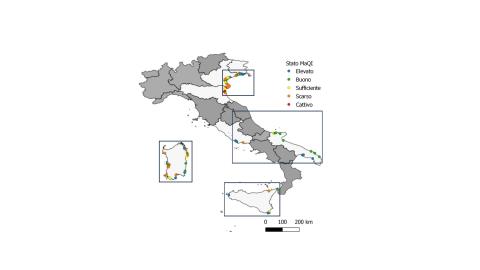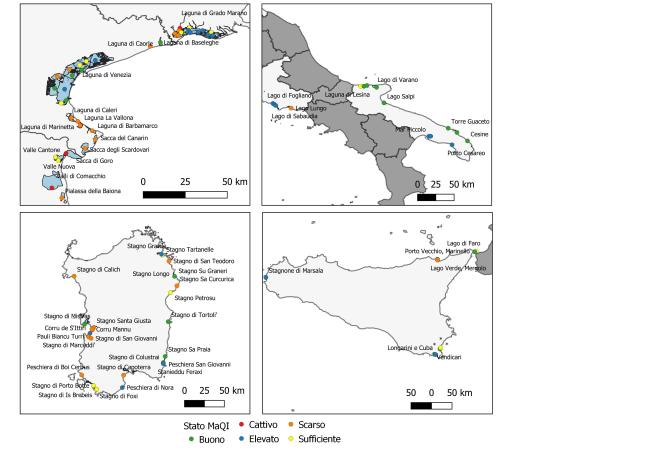Panel 1
Valentina Bernarello, Andrea Bonometto, Rossella Boscolo Brusà, Federica Cacciatore, Federica Oselladore, Emanuele Ponis
The MaQI (Macrophyte Quality Index) (Sfriso et al., 2014), formally adopted by Italy for the classification of the ecological status of transitional environments under Directive 2000/60/EC, integrates the two biological quality elements: macroalgae and aquatic phanerogams. The MaQI responds to anthropogenic pressures affecting transitional areas and describes the ecological quality status in five classes: high, good, moderate, poor, and bad.
The current monitoring programs in Italian transitional waters provide for two semi-annual samplings within one year of each three-year period. Since 2014, three sampling campaigns have been carried out in almost all regions. In the 2020-2022 three-year period, the MaQI index was applied to 91 Italian transitional water bodies across seven regions. Of these, 23.1% were classified as having a "high" ecological status, 23.1% as "good," 22.0% as "moderate," 28.5% as "poor," and 3.3% as "bad." Nationally, for the regions where data is available (7 out of 9), 46.2% of transitional water bodies met the quality target ("good" or "high").
The Macrophyte Quality Index is a multimetric index based on:
- Number and percentage of sensitive macroalgal species
- Relative abundance of Rhodophyta and Chlorophyta
- Percentage cover of macroalgae
- Percentage cover of different species of aquatic phanerogams (ISPRA, 2011)
This index provides a synthetic ecological classification of the ecosystem using structural parameters (coverage, composition, and abundance) of the macrophyte community in soft-bottom environments. The MaQI, supported by extensive literature, summarizes the complexity of soft-bottom vegetative communities, offering an ecological interpretation of the examined ecosystem. The index is applicable to all Italian water bodies with an average annual salinity above 5 and has been intercalibrated with other EU member states to ensure comparability of results at the Mediterranean level.
The MaQI value ranges from 0 to 1 and corresponds to the Ecological Quality Ratio (EQR) required by the Water Framework Directive 2000/60/EC. The class limits are defined in the reference regulation D.Lgs. 152/2006 and subsequent amendments.
To classify the ecological quality status of transitional water bodies using the biological quality elements "macroalgae" and "aquatic phanerogams."
- Directive 2000/60/EC
- D.Lgs. 152/2006 and subsequent amendments
- Decision 2018/229/EU
Directive 2000/60/EC (transposed by D.Lgs. 152/06 and subsequent amendments) establishes a regulatory framework for all Member States to protect surface waters, transitional waters, coastal waters, and groundwater. It aims to improve all natural, artificial, and heavily modified water bodies to achieve good water status within the deadlines set by current regulations.
The MaQI index was officially designated for classifying the Biological Quality Element "Macrophytes" in Italian transitional waters by DM 260/2010 and incorporated into Decision 2018/229/EU following the Mediterranean intercalibration process.
Panel 2
- Sfriso, A., Facca, C., Ghetti, P.F., 2007. Rapid Quality Index, based mainly on Macrophyte Associations (R-MAQI), to assess the ecological status of transitional environments. Chemistry and Ecology, 23 (6): 1-11.
- Sfriso, A., Facca, C., Ghetti, P.F., 2009. Validation of the Macrophyte Quality Index (MaQI) set up to assess the ecological status of Italian marine transitional environments. Hydrobiologia, 617, 117-141.
- Sfriso, A., Facca, C., Bonometto, A., Boscolo, R., 2014. Compliance of the Macrophyte Quality Index (MaQI) with the WFD (2000/60/EC) and ecological status assessment in transitional areas: The Venice lagoon as a study case. Ecological Indicators 46, 536–547.
- ISPRA, 2009. Implementation of Directive 2000/60/EC - Classification of the ecological status of marine coastal and transitional water bodies.
- ISPRA, 2010. Implementation of Directive 2000/60/EC - Guidelines for the application of the MaQI index.
- ISPRA, 2011. Protocols for sampling and determining biological and physico-chemical quality elements within the monitoring programs under Directive 2000/60/EC for transitional waters.
- ISPRA-UNIVE, 2012. Variations in the Macrophyte Quality Index (MaQI) following intercalibration results in the Mediterranean Ecoregion (Med-GIG).
Constant updating of the species list used.
Data quality assessment
Coastal ARPA, SINTAI
Nazionale (7/9)
2014-2016; 2017-2019; 2020-2022
Indicator assessment
To apply the MaQI, the following parameters must be determined:
- Systematic identification of macroalgal taxa at the species level and determination of the number and percentage of sensitive taxa present (ISPRA, 2010).
- Total cover and relative abundance of dominant macroalgae. It is sufficient to discriminate between cover greater or less than 5% and the relative abundance of Chlorophyta and Rhodophyta.
- Identification and relative percentage cover of individual phanerogam species.
The metrics are combined through a two-entry matrix (for macroalgae and phanerogams, respectively), which directly provides the EQR value and the BQE status (ISPRA, 2012). The MaQI value ranges from 0 to 1, with class limits defined in the reference regulation (D.Lgs. 152/06 and subsequent amendments), categorizing five classes: high, good, moderate, poor, and bad.
Analysis of the MaQI index for the 2020-2022 period shows that, of the 91 water bodies assessed (Table 1):
- 3 were in "bad" ecological status (3.3%)
- 26 in "poor" status (28.5%)
- 20 in "moderate" status (22%)
- 21 in "good" status (23.1%)
- 21 in "high" status (23.1%)
Comparing different three-year periods shows a progressive increase in water bodies classified as "good" or "high" (24.2% in the first, 27.3% in the second, and 38.2% in the third) for tidal water bodies. For non-tidal water bodies, an increase was observed between the first and second periods (from 56.3% to 62.3%), followed by a decrease in the third (50.9%) (Figure 2).
Data
Figure 1st: EQB Macrofite MaQI, ecological quality status of macrophytes in Italian transitional water bodies. Triennium of monitoring 2020-2022crofite MaQI, stato di qualità ecologica delle macrofite nei corpi idrici di transizione italiani. Triennio di monitoraggio 2020-2022
Coastal ARPA, SINTAI
Figure 1b: EQB Macrofite MaQI, ecological quality status of macrophytes in Italian transitional water bodies (zoom on the water bodies of the 7 regions). Triennium of monitoring 2020-2022
Processing by ISPRA in collaboration with ARPA FVG, ARPAV, ARPAE Emilia-Romagna, ARPA Puglia, ARPA Lazio, ARPA Sicilia, ARPA Sardegna based on SINTAI data, coastal ARPA
Figure 2: MaqI Macrophyte EQB. Ecological quality status of macrophytes in tidal and non-thidal transitional waters by MaQI index - comparison 1st three years (2014-2016), 2nd three-year period (2017-2019) and 3rd three-yearly and three-yearly (2020-2022) of monitoring
ISPRA Elaboration in collaboration with ARPA FVG, ARPAV, ARPA Emilia-Romagna, ARPA Puglia, ARPA Lazio, ARPA Campania, ARPA Sicilia, ARPA Sardegna on SINTAI, ARPA costal data
n. CI number Water Bodies
For non-thillary bodies, all data available for three three-yearly monitors were considered.
Table 1: EQB Macrofite MaQI, ecological quality status of macrophytes in Italian transitional waters at regional and overall level
ISPRA Elaboration in collaboration with ARPA FVG, ARPAV, ARPAE Emilia Romagna, ARPA Lazio, ARPA Puglia, ARPA Sicilia, ARPA Sardegna on SINTAI data, ARPA costal
No. CI number Water Bodies
Table 2: EQB Macrofite MaQI. Ecological quality status of macrophytes in transitional waters grouped by "tidal/non-cidal" type. Comparison 1st three-year period (2014-2016), 2nd three-year period (2017-2019) and 3rd three-yearly (2020-2022) of monitoring
ISPRA Elaboration in collaboration with ARPA FVG, ARPAV, ARPAE Emilia Romagna, ARPA Lazio, ARPA Puglia, ARPA Campania, ARPA Sicilia, ARPA Sardegna on SINTAI, ARPA coastal data
No. CI number Water Bodies
For non-thillary bodies, all data available for three three-yearly monitors were considered.



The application of the MaQI index in national transitional waters provides a general assessment of the macrophytic component for the regions of which the data are available (7 out of 9), which include a total of 91 transitional water bodies, belonging to 7 regions: Friuli-Venezia Giulia (13 CI); Veneto (19 CI); Emilia-Romagna (5 CI); Lazio (4 CI); Puglia (11 CI); Puglia (11 CI); Sicily (13 CI) and Sardinia (26 CI). (Figure 1a - 1b). The transition waters falling within the “focivial” type have not been considered in the counting and processing, to which the indicator is not currently applicable. At the national level, the data, relating to the three-year period 2020-2022, show that 46.2% of transitional water bodies have achieved the quality objective ("good" or "high"). At the level of individual regions (Table 1), 90.9% of the water bodies of Puglia and 75% of Lazio reach the quality target; lower percentages are found for Sicily and Friuli-Venezia Giulia (46.2% and 46.1%, respectively), Sardinia (38.5%), Veneto (36.8%), while in Emilia-Romagna no body of water has a state of “high or good” quality. If you group the bodies in the "tidal/non-tidal" category (Table 2, Figure 2), it is observed that they reach the "good" or "high" state 38.2% of the "tidal" CIs (13 out of 34) and 50.9% of the CI "non-tidal" (29 out of 57).